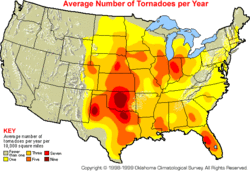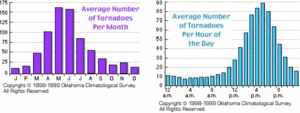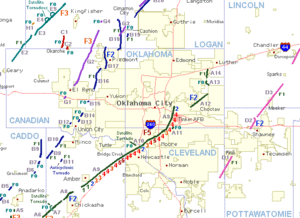Tornadoes
| Topics: |
Contents
Introduction Figure 1: Tornado photographed on June 2, 1995 south of Dimmitt, Texas. (Source: NOAA Photo Library (Tornadoes) - National Severe Storms Laboratory).
A tornado is a vortex of rapidly moving air associated with some severe thunderstorms (see Figure 1). Tornadoes that travel across lakes or oceans are called waterspouts. Winds within the tornado funnel may exceed 500 kilometers per hour. High-velocity winds cause most of the damage associated with these weather events. Tornadoes also cause damage through air pressure reductions. The air pressure at the tornado center is approximately 800 millibars (average sea-level pressure is 1013 millibars) and many human-made structures collapse outward when subject to pressure drops of this magnitude. The destructive path of a tornado is usually about half a kilometer wide, and usually no more than 25 kilometers long. However, a spring tornado in 1917 traveled 570 kilometers across Illinois and Indiana lasting well over 7 hours.
About 74% of all tornadoes have wind speeds between 65 and 181 kilometers per hour. These events are classified according to the Fujita tornado intensity scale as being weak (Table 1). Damage from these tornadoes varies from broken windows and tree branches to shingles blowing off roofs and moving cars pushed from roads. Weak tornadoes have a path that is about 1.5 kilometers long and 100 meters wide, and they generally last for only 1 to 3 minutes. According to the Fujita scale, strong tornadoes can have wind speeds between 182 and 332 kilometers per hour. These phenomena cause considerable damage and occur about 25% of the time. Strong tornadoes can have a course up to 100 kilometers long and half a kilometer wide, and they can last for more than 2 hours. The rarest tornadoes are those with either a F4 or F5 rating. These events have wind speeds between 333 to 513 kilometers per hour and are very destructive and violent. F4 tornadoes occur only about 1% of the time, while F5 are even more rare with a chance of about 1 in 1000 of happening.
| Table 1: Fujita tornado intensity scale. | |||
|---|---|---|---|
| F-Scale | Category | Kilometers per Hour (Miles per Hour) |
Comments |
| 0 | Weak | 65-118 (40-73) | Damage is light. Chimneys on houses may be damaged; trees have broken branches; shallow-rooted trees pushed over; some windows broken; damage to sign boards. |
| 1 | Weak | 119-181 (74-112) | Shingles on roofs blown off; mobile homes pushed off foundations or overturned; moving cars pushed off roads. |
| 2 | Strong | 182-253 (113-157) | Considerable damage. Roofs torn off houses; mobile homes destroyed; train boxcars pushed over; large trees snapped or uprooted; light-objects thrown like missiles. |
| 3 | Strong | 254-332 (158-206) | Damage is severe. Roofs and walls torn off better constructed homes, businesses, and schools; trains overturned; most trees uprooted; heavy cars lifted off ground and thrown some distance. |
| 4 | Violent | 333-419 (207-260) | Better constructed homes completely leveled; structures with weak foundation blown off some distance. |
| 5 | Violent | 420-513 (261-318) | Better constructed homes lifted off foundations and carried considerable distance where they disintegrate; trees debarked; cars thrown in excess of 100 meters. |
 Figure 2: Average number of tornadoes per year in the United States. (Source: Oklahoma Climatological Survey).
Figure 2: Average number of tornadoes per year in the United States. (Source: Oklahoma Climatological Survey). Tornadoes occur in many parts of the world. Some notable hots spots include South Africa, Australia, Europe, New Zealand, northern India, Canada, Argentina, Uruguay, and the United States. Of these locations, the United States has some specific regions within its boundaries that have an extremely high number of events per year. Figure 2 describes the spatial distribution of tornado frequency in the United States. The highest number of tornadoes occurs in the southern plains (also called Tornado Alley), south of Lake Michigan, and west central Florida.
 Figure 3: Average number of tornadoes per month and per hour of the day in the United States. (Source: Oklahoma Climatological Survey).
Figure 3: Average number of tornadoes per month and per hour of the day in the United States. (Source: Oklahoma Climatological Survey). Tornado occurrence has some interesting temporal characteristics. In the United States, most tornadoes occur in April, May, June, and July (Figure 3). It is during these months that we get the conditions necessary for the formation of severe thunderstorms. Tornadoes also have particular times of the day in which they form. Most tornadoes form in the afternoon. Few develop in the late evening or early morning. During these times, heating of the Earth's surface is minimal or not occurring. Intense heating enhances updrafts in severe thunderstorms. It is these updrafts that can cause a tornado to form.
| Table 2: Ten deadliest tornado events in the United States. | ||
|---|---|---|
| Date | Location(s) | Deaths |
| March 18, 1925 | Missouri, Illinois, Indiana | 689 |
| May 6, 1840 | Natchez, Mississippi | 317 |
| May 27, 1896 | St. Louis, Missouri | 255 |
| April 5, 1936 | Tupelo, Mississippi | 216 |
| April 6, 1936 | Gainesville, Georgia | 203 |
| April 9, 1947 | Woodward, Oklahoma | 181 |
| April 24, 1908 | Amite, Louisiana and Purvis, Mississippi | 143 |
| June 12, 1899 | New Richmond, Wisconsin | 117 |
| June 8, 1953 | Flint, Michigan | 115 |
| May 11, 1953 | Waco, Texas | 114 |
In the United States, about 40,000 tornadoes have occurred in the last fifty years (1950-1999). Data for the period 1916 to 1996 indicates that the frequency of tornadoes in the United States has increased substantially (Figure 4). However, part of this trend may be due to increased population densities. More people per unit area means a greater chance of seeing this relatively rare weather event. Two other factors that could also be responsible for the perceived increase in tornado numbers may be satellite imaging and weather radar. Both of these technologies allow us to pinpoint the thunderstorms that may generate funnels.
 Figure 4: Average number of tornadoes and tornado fatalities per year in the United States for the period 1916 to 1996. (Source: Oklahoma Climatological Survey).
Figure 4: Average number of tornadoes and tornado fatalities per year in the United States for the period 1916 to 1996. (Source: Oklahoma Climatological Survey). Total damage from tornadoes over the last 50 years has been estimated to be about 25 billion dollars. Tornadoes also take a heavy toll on human lives. Table 2 describes the ten deadliest tornado events in the United States. However, weather forecasting technology has played an important role in reducing the number of lives lost (Figure 4). In the decade of the 1930s, before the advent of severe weather forecasting, 1,945 people were killed by tornadoes. From 1986 to 1995, only 418 individuals perished suggesting a 90% decrease in fatalities. This reduction is even more astonishing when you consider that the population of the United States doubled from 1935 to 1990.
Oklahoma, May 3, 1999
 Figure 5: Tornado paths in and around Oklahoma City on May 3, 1999. Individual tornado tracks are identify by different colors. Tornado intensity is given by Fujita Scale values. Note that the largest tornado track, that cuts through the center of the city, has intensity values recorded along its entire path. (Source: NOAA National Weather Services Southern Region - The Central Oklahoma Tornado Outbreak of May 3, 1999).
Figure 5: Tornado paths in and around Oklahoma City on May 3, 1999. Individual tornado tracks are identify by different colors. Tornado intensity is given by Fujita Scale values. Note that the largest tornado track, that cuts through the center of the city, has intensity values recorded along its entire path. (Source: NOAA National Weather Services Southern Region - The Central Oklahoma Tornado Outbreak of May 3, 1999). Tornadoes can cause considerable damage to natural and human-made structures on the Earth's surface. Often, they also cause the injury and death of people. One particular event that set new monetary records in destruction occurred in Oklahoma on May 3, 1999. The destruction from this meteorological event began at 4:45 in the afternoon and ended about six hour later. During this time period, about 70 tornadoes were spawned along a 240-kilometer-long swath that began in southwest Oklahoma.
Oklahoma receives more tornadoes per square kilometer than any other region found on our planet. It also receives most of these severe events in the month of May when warm moist air from the Gulf of Mexico interacts with cold fronts descending from the northwest. On the morning of May 3rd, forecasters at NOAA's Storm Prediction Center predicted only a slight risk for severe weather across parts of Oklahoma, Texas, and Kansas. However, by the afternoon conditions for tornado generation had improved greatly. Clearing skies provided the solar radiation required to increase surface temperatures and enhance convective development of severe thunderstorms. A kink in the jet stream, known as a short wave, strengthened upper air winds traveling from the east. Strong upper air winds have a tendency to enhance the vertical mesocyclonic circulation occurring inside developing thunderstorms. This information was added to the high-resolution computer forecast model at the Storm Prediction Center. At 3:49, the Storm Prediction Center updated the forecast and issued a tornado watch. Less than an hour later the damage began.
The greatest damage on May 3 occurred when the funnels cut through Oklahoma City (Figure 5). The damage to the urban area stretched over 60 kilometers and was at times more than a kilometer wide. In some places, winds from the funnel were traveling about 420 to 510 kilometers per hour! More than 2,500 buildings were destroyed and another 7,500 were damaged. Total damage to structures and other property was estimated to be about 1.2 billion dollars. The toll on human life, for the entire state, was 40 individuals. This number would have certainly been much higher if radio and television warning systems did not exist.